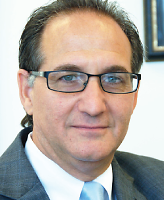Judge Steven Leifman, J.D., learned in his early days on the bench of the 11th Judicial Circuit in Florida that far too many of the people awaiting trial or incarcerated were mentally ill.
The problem was what to do next.
An average of 1,200 inmates a day in the local prison were taking psychiatric medications, and the county was paying $60 million a year to house them.
Most were not there for serious crimes but still spent longer times behind bars than other prisoners and, when finally released, had no provision for follow-up treatment, Leifman said at APA’s 2012 annual meeting in Philadelphia in May.
Nationally, the situation was similar. In 1955, state hospitals housed 560,000 patients, proportionately equivalent to 1.5 million today. Now, fewer than 40,000 inpatient psychiatric beds remain in the United States, but 550,000 people with mental illness are housed in jails and prisons, with another 900,000 in community control, said Leifman, who serves on the board of the American Psychiatric Foundation.
“We never deinstitutionalized; we just transferred responsibility from a hospital system to the prison system,” he said. Those prisoner/patients are doubly stigmatized as mentally ill and as criminals, making it harder for them to reintegrate into society.
Meanwhile, public mental health funding is growing only in the forensic sector, said Leifman. And that’s not for treating people for their own sake.
Most of the treatment goes to restore competency to stand trial for 3,000 people a year, he said. Most of those plead out. Many other cases are dropped because witnesses are gone or the detainee has already served as much time as the sentence for the crime would be. In any case, most are released without any provision for treatment and are likely to be rearrested soon thereafter.
“Most recidivism happens in the first 25 days post-release,” he said. “Our goal is to integrate them back into the community with this support.”
Since 2008, the program has saved the county 23 years of jail-bed days, cut recidivism in this population from 72 percent to 20 percent, and reduced harm to suspects and police officers.
Working over several years with many others in Miami, Leifman helped develop a program to keep more mentally ill people out of the criminal justice system or return them sooner to the community. The program included training 3,600 police officers to deal with mentally ill individuals in the community. “The officers have become social workers, and they love what they’re doing,” he stated.
Available also is postarrest diversion with peer support, housing, expedited benefits, and screening tools to be used by staff in the jails. In addition a $22 million bond issue is funding construction of a forensic diversion facility in Miami.
But more must be done to see that people with mental illnesses are treated and not incarcerated, said Leifman. The current mental health system, developed over the last 50 years, is “fragmented, underresourced, and in need of reforming.”
“No one person, party, or institution caused this problem, and no single one will fix it,” he said. “Everyone was doing his own job and didn’t see the complete picture. We must develop a collaboration among all parties: public defenders, states’ attorneys, law enforcement, families, consumers, and the psychiatric community.”
Leifman helped start the Judges Leadership Initiative, which has helped several hundred judges from around the country work on this issue in their own communities. Together with APA, he helped start the Psychiatric Leadership Group, working with psychiatrists to help them help judges and others working in the criminal justice system to better understand psychiatric disease and deal more appropriately with these individuals when they come into the court system.


